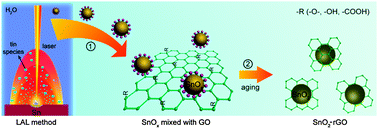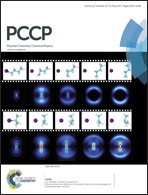A novel reduction approach to fabricate quantum-sized SnO2-conjugated reduced graphene oxide nanocomposites as non-enzymatic glucose sensors†
Abstract
Quantum-sized SnO2 nanocrystals can be well dispersed on reduced graphene oxide (rGO) nanosheets through a convenient one-pot in situ reduction route without using any other chemical reagent or source. Highly reactive metastable tin oxide (SnOx) nanoparticles (NPs) were used as reducing agents and composite precursors derived by the laser ablation in liquid (LAL) technique. Moreover, the growth and phase transition of LAL-induced SnOx NPs and graphene oxide (GO) were examined by optical absorption, X-ray diffraction, X-ray photoelectron spectroscopy, Raman spectroscopy and high-resolution transmission electron microscopy. Highly dispersed SnOx NPs can also prevent rGO from being restacked into a multilayer structure during GO reduction. Given the good electron transfer ability and unsaturated dangling bonds of rGO, as well as the ample electrocatalytic active sites of quantum-sized SnO2 NPs on unfolded rGO sheets, the fabricated SnO2–rGO nanocomposite exhibited excellent performance in the non-enzymatic electrochemical detection of glucose molecules. The use of LAL-induced reactive NPs for in situ GO reduction is also expected to be a universal and environmentally friendly approach for the formation of various rGO-based nanocomposites.


 Please wait while we load your content...
Please wait while we load your content...